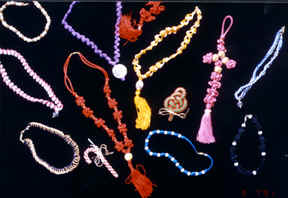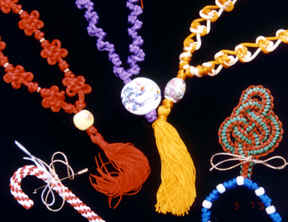
| Index |
Background Information
Chinese Knot Art collided with me September 1989. I was working registration for the local adult school, enrolling adult students in classes. One sorry classroom had but three students waiting to be signed up. The class would not make it. They need one more student. The teach was Chinese, the class was Chinese Knot Art. Samples of the teacher’s work were displayed on the counter. I was enthralled. I became student number four.
 |
Each week I learned a few new knots and completed many projects (pictures
1 & 2). But quickly I discovered I could not wear the nylon cord that the necklaces
were made from. The nylon was also expensive and difficult to find. The closures were
cheap looking. I was longing for my handspun, natural fibers. I wanted to put the knots on
garments and not just wear jewelry. It needed to look more "me’ and not copies
of everyone else’s work. I began to experiment and that was the foundation of this
study. |
| Ancient Chinese Knot art was made of silk, cotton or hemp.
Archaeologists have dated knotting tools back 100,000 years in china (Chinese Knotting,
Echo Craft books). Each dynasty left signs of knotted art either in their paintings,
depictions on pottery or some of the knotted cords survived (Pictures 3, 4 & 5). Many of the knots were
functional but all were beautiful. Even as recent as the 1930’s, knotting was part of
everyday life in china. But with the revolution and the communist rule, knotting became a
thing of the past. Resurgence of the art began in the mid 1970’s with university
classes in Taiwan. Currently only one book on Chinese Knotting is published in English in
the United States. (I only found one book at the time of this
writing.) Picture 2 |
 |
Much of ancient Chinese knot art that has survived
is made from silk. The heavier cords were generally core spun over hemp, linen and cotton
multi-ply cords. Sizing was used in much of the cords. Complicated knots were sewn
together to keep their shape or complete the knot. Yarns were made of singles, core yarns
and multi-plies. Today most knotted novelties are made from synthetics: nylon, polyester
and rayon. But I prefer natural fibers and feel these synthetics do not do justice to the
beauty of the Chinese Knot art. Silk and ceramic beads become one in a necklace, hemp and
wood beads have rustic appeal knotted together in a handbag. Natural fibers have a unique
and beautiful signature all their own.
Sailors made mats for the decks of their ships to protect the blocks
(pulleys). The mats were originally made from hemp rope. Many of these mats were beautiful
designs, some from a flattened Turk’s Head or from a button knot, all were very
durable. The seamen incorporated knots from all over the world. The Incas, Persians, and
North American Indians all used ornamental knots from early centuries usually made from
vegetable fibers. Though Romans, Greeks and Egyptians used them—none are depicted in
their art but are revealed in their mythology (Encyclopedia of Knots and Fancy rope work,
Cornell Maritime Press). Different early European cultures were extremely superstitious
over knots. But influence from all these different areas show up in the nautical knots. It
appears that the sailors tied much of the world together.
The ancient art of Chinese Knotting is once again making a comeback.
Many classes are offered at craft stores, bead shops and adult centers. Current and
antique necklaces, earrings and ornaments are once again found in novelty shops (sample 1, preliminary work). Knotted adornments are
incorporated into some of the top-of-the-line women’s wear.
To receive the most out of this study, I decided to use as many
types of fibers as time allowed, from fine silk to heavy yak. I wanted each fiber to be
suitable for its use and use knots in as many facets of fiber art as possible. How do you
make cords for knotting from soft fine fleece and congenial to the entire project? How a
project coordinates as a whole is crucial to me. Five projects cannot do justice to the
possibilities.
My first step was to learn the knots. This I accomplished with
instruction from the adult school teach and study of existing knots on works in stores.
Also, I interviewed expert knotters in my area. Information regarding knotting was
generous but everything applied to the synthetic cords. I realize that by
definition a cord is a yarn that is composed of plies of multiple plies. But when
knotting, metal wire, leather, twine, rope, yarn and string are called "cords".
I will use the term "cord" interchangeably with yarn in this study because it
becomes redundant to continue to mention "cords and yarns".
The inspiration for the Polwarth sweater project came from my lack of
desire to weave anything complicated. This would be a good way to liven up my simple
tabby. I love Polwarth and this would demonstrate how t spin soft, fine, fluffy fiber into
usable knotting yarn. The linen belt stems from the first half COE requirements. I loved
the heavy linens that I spun but did not plan to hide them in a bound weave rug. The knots
might show off the best of the linen.
The yak and karakul rug was inspired by the nautical mats made from the
Turk’s head knot. But I wanted something more unique and I didn’t plan to spin
hemp rope.
Much of my fiber art work is done with silk and dyeing silk. Silk
fabric cr4aps are never ending. No one wants to waste such precious fiber, but what can
you do with it? I wanted to incorporate it back into fine wearables. Spinning the scraps
into usable cords appealed to me.
An ad from the Smithsonian sales magazine had a pin made from silver
wire manipulated into a beautiful knot. It was the ultimate challenge: spin a gold thread
to knot! I just had to figure out how. Fine thread need to be part of this study. The gold
knot could hang on a knotted necklace!
Because of the limitations of the instruction; information, discussion
and sample of cotton, alpaca, angora, Scottish blackface and numerous commercial yarns
will be found in section 5.
| Index |